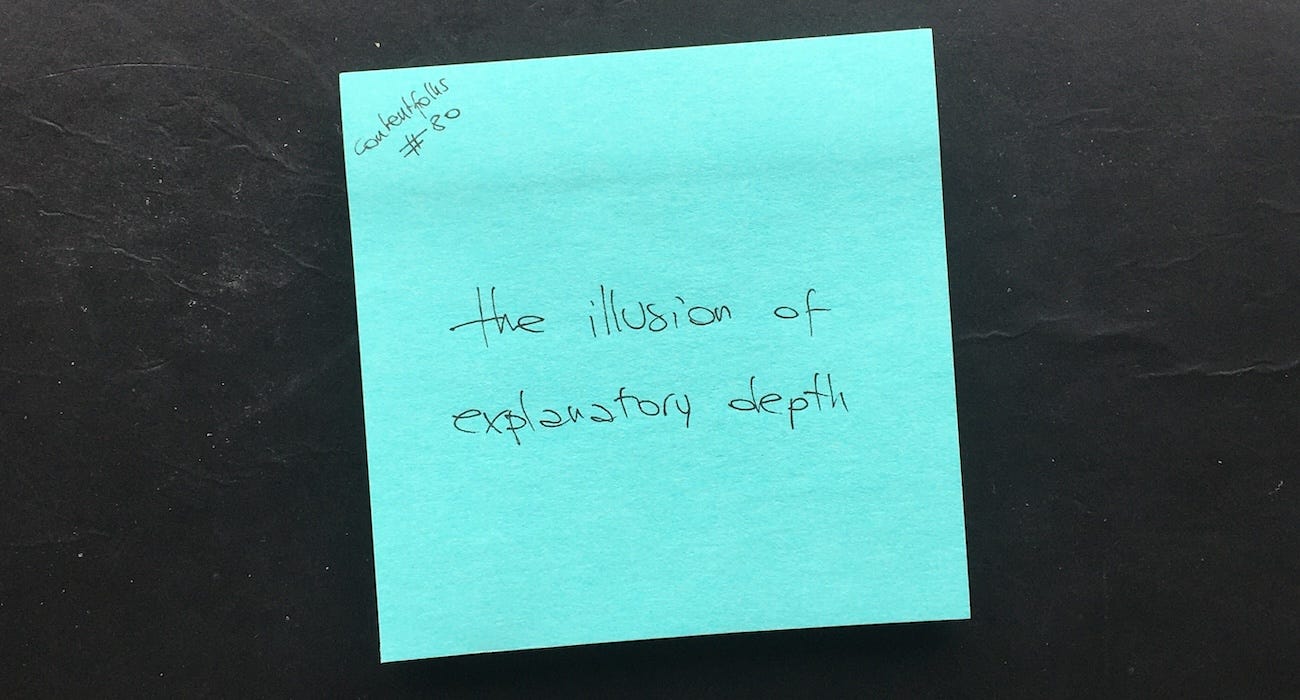cf #80: the illusion of explanatory depth
or: do you know how zippers work?
You are reading contentfolks—a fortnightly sporadic blend of sticky notes, big content ideas, and small practical examples. Thank you for being here! ~fio
Hey there 👋
I assume that you, like me, are familiar with zippers (or zips here in the UK) and have used them multiple times to open a backpack or fasten a coat.
But if I asked you to explain how they work, could you do it?
Let’s try → spend 30 seconds explaining to yourself how a zipper zips in one direction and unzips in the other.
Go:
.
.
.
.
.
.
.
.
.
.
.
How easy was it?
If you’re like the majority of people, the answer is probably “harder than I expected.”
The illusion of explanatory depth (IoED)
What you just experienced is a sneaky cognitive bias, the illusion of explanatory depth:
Most people feel they understand the world with far greater detail, coherence, and depth than they really do. They are subject to an illusion of explanatory depth […that reflects] a genuine miscalibration in people’s sense of how well they understand the workings of the world around them.1
In other words: we overestimate our understanding of how things work, and are unaware of the overestimation unless or until we’re prompted to give a detailed explanation.
This cognitive bias is pervasive, so it naturally finds its way into our profession as content marketers—a profession that, very often, requires us to give detailed explanations to educate our audiences and customers. We aim to deliver well-researched, nuanced, and actionable work; without an awareness of this bias, we instead risk:
Underestimating the complexities of a topic or concept, so our content is overly simplistic
Believing we can rely on general knowledge or cursory research only, so we fail to seek input from experts or SMEs
Assuming we have a deeper understanding of a topic than we do, so we miss our blindspots and/or misinterpret key concepts without realising
The solution is often a mix of doing extensive research, interviewing experts, and working with strong editors—but you can only address a bias if you know it’s there in the first place.
💡 A practical example 💡
When I came up with the idea for this issue, I decided to use myself as a test subject and write an explanation of how a zipper works. Within seconds, I confirmed the existence of the IoED bias: I (sort of) understood how the two halves interlocked, but couldn’t figure out how or why they’d come apart.
So I did some Googling to understand the mechanism, watched a couple of YouTube videos to see it in action, then got very sidetracked by a 36-video playlist that goes into fascinating detail about every type of zipper ever manufactured.2
After all this, I came up with this explanation:
A zipper track is made of two strips with alternating hooks and hollows, a slider that moves up and down along the track, and a pull tab.
When you pull the slider up, the strips enter it from separate sides and take a Y-shaped path. Where the space narrows, the hooks on either side are pushed into the hollows on the opposite side, which makes the strips interlock.
When you pull the slider down, a wedge mechanism3 inside it pushes against the edge of each hook and pivots it off the hook below, disengaging the mechanism and separating the two tracks.
The paragraph above is good enough, but I really struggled to write it. I went through what felt like hundreds of revisions and tweaks—and that was for something I’ve used my entire life! How does this compare to our work, where we rarely have first-hand experience with the software, service, or category we’re talking about?
Try these other experiments 🧪🧑🔬
Now that you’re aware of the illusion of explanatory depth, I know you’ll keep your eyes open and maybe change a thing or two about the way you approach content creation. And if you ever want to have 10 extra minutes of fun,4 I recommend trying to come up with in-depth explanations for how a few other things work:
A bicycle
A cylinder lock
Sending and receiving emails
Your heart
Bonus points if you reply and send me some of these explanations, so I don’t have to Google them 😉
For the academically minded and/or the generally curious, two interesting papers to (skim)read → Broad effects of shallow understanding: explaining an unrelated phenomenon exposes the illusion of explanatory depth and The misunderstood limits of folk science: an illusion of explanatory depth.
I didn’t watch all of them—but let me go into full elder millennial mode and mention how I enjoyed these super-niche, extremely dry, very grainy videos from a decade+ ago that taught things slowly without special effects, flashing lights, ominous sounds, and/or pointed looks to camera. Bliss.
…but, like, did YOU know about the wedge?!? 🤯
Okay, so maybe my idea of ‘fun’ is different from yours, but these days I mostly find it amusing that, for all the time we spend contemplating AI, algorithms, and other abstract and intangible things, we barely understand how the physical world around us works. What I’m trying to say is—it’s hard to take yourself seriously once you acknowledge that you’ve been using zippers all your life and had zero clue how they worked.





Thanks Fio! I really liked the footnotes. And I think you nailed it in the last footnote. We dream big but have low understanding of how our everyday tools work.